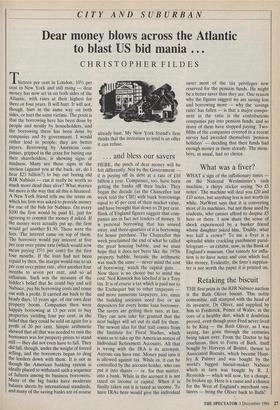CITY AND SUBURBAN
Dear money blows across the Atlantic to blast US bid mania •1•
CHRISTOPHER FILDES
Thirteen per cent in London, 101/2 per cent in New York and still rising — dear money has now set in on both sides of the Atlantic, with rates at their highest for three or four years. It will hurt. It will not, though, hurt in the same way on both sides, or hurt the same victims. The point is that the borrowing here has been done by people and mostly by householders, and the borrowing there has been done by companies and by government. I would rather lend to people; they are better payers. Borrowing by American com- panies, gripped in the craze for buying out their shareholders, is showing signs of madness. Many see those signs in the auction (against you at the back, sir, do I hear $23 billion?) to buy out boring old RJR Nabisco — can it really be worth so much more dead than alive? What Worries me more is the way that all this is financed. A New York friend tells me the terms on which his firm was asked to provide money for one of the bids for Nabisco. On every $100 the firm would be paid $1, just for agreeing to commit the money if asked. If the money were actually put up, the firm would get another $1.50. Those were the fees. The interest came on top of them. The borrower would pay interest at five per cent over prime rate (which would now mean paying 151/2 per cent) for the first four months. If the loan had not been repaid by then, the margin would rise to six per cent over prime rate, after another four months to seven per cent, and so ad infinitum. Such was the measure of the bidder's belief that he could buy and sell Nabisco, pay his borrowing costs and come out with a profit. It carried me back to the heady days, 15 years ago, of our own dear property boom. Companies then were happily borrowing at 13 per cent to buy properties yielding four per cent, in the belief that they could be sold on again for a profit of 20 per cent. Simple arithmetic showed that all that was needed to ruin the borrowers was for property prices to stand still — they did not even have to fall. They did fall, though, under the weight of forced selling, and the borrowers began to drag the lenders down with them. It is not as though the American banking system is ideally placed to withstand such a sequence of failures among its business borrowers. Many of the big banks have moderate balance sheets by international standards, and many of the saving banks are of course already bust. My New York friend's firm thinks that the invitation to lend is an offer it can refuse.


































































 Previous page
Previous page